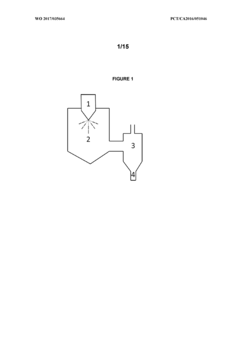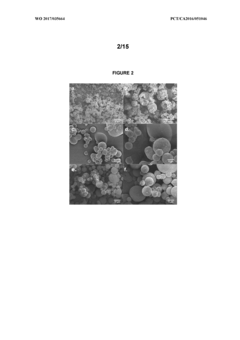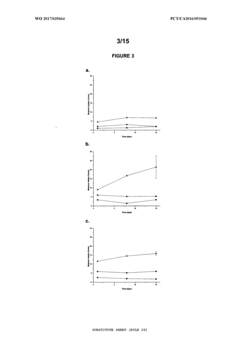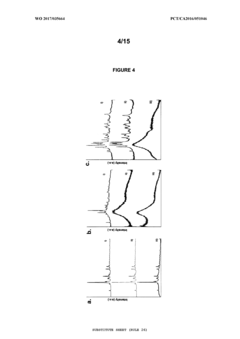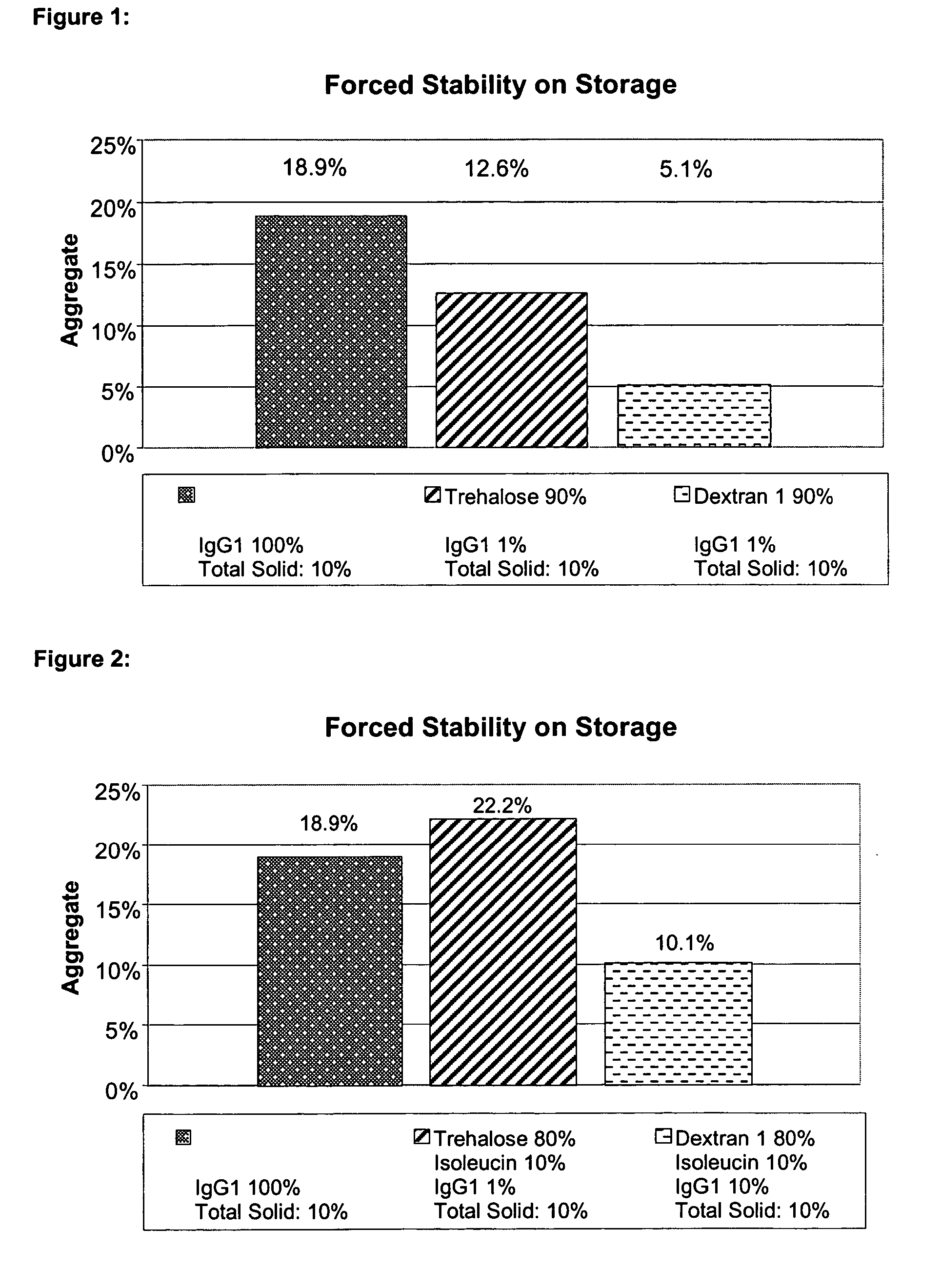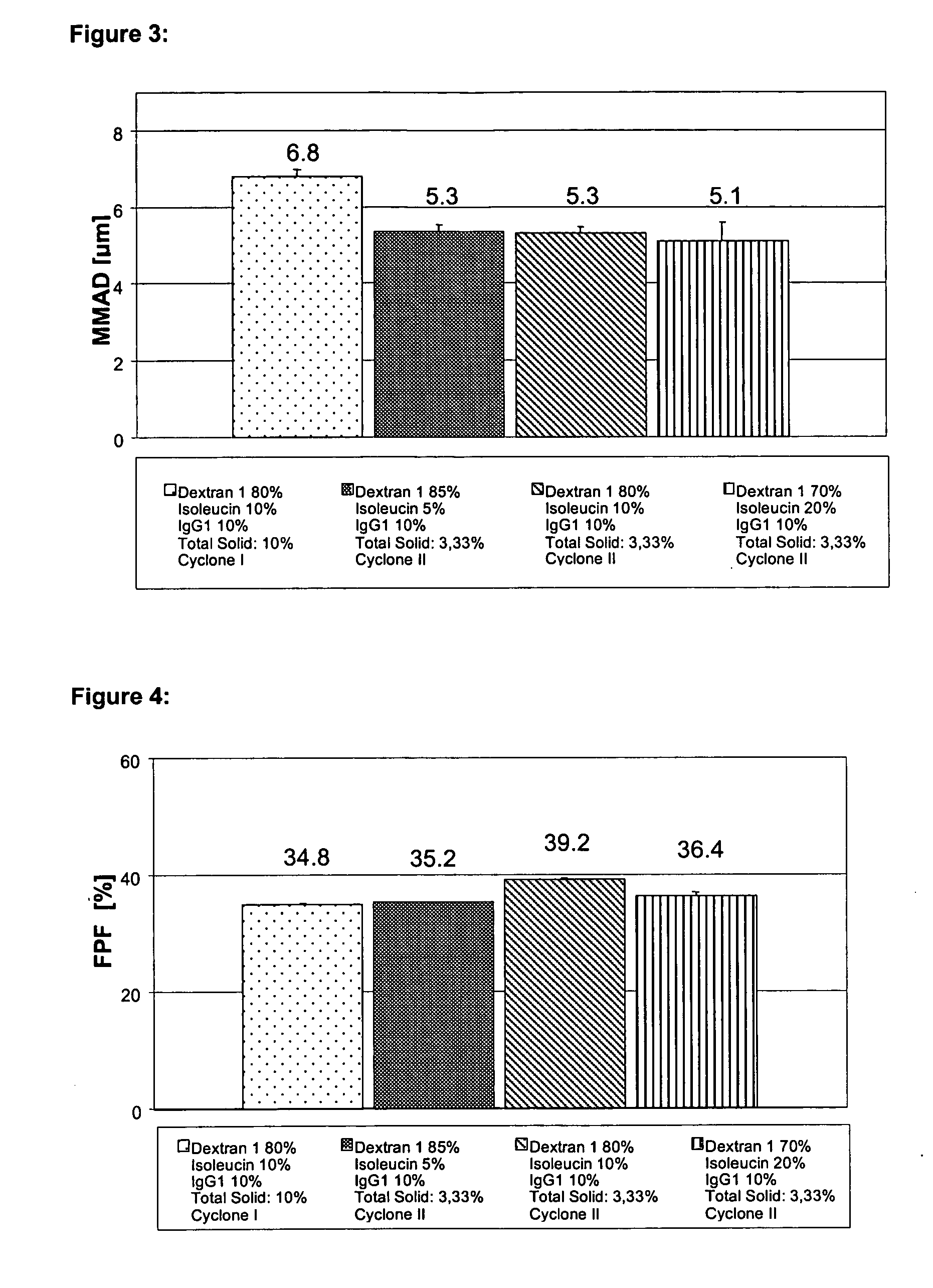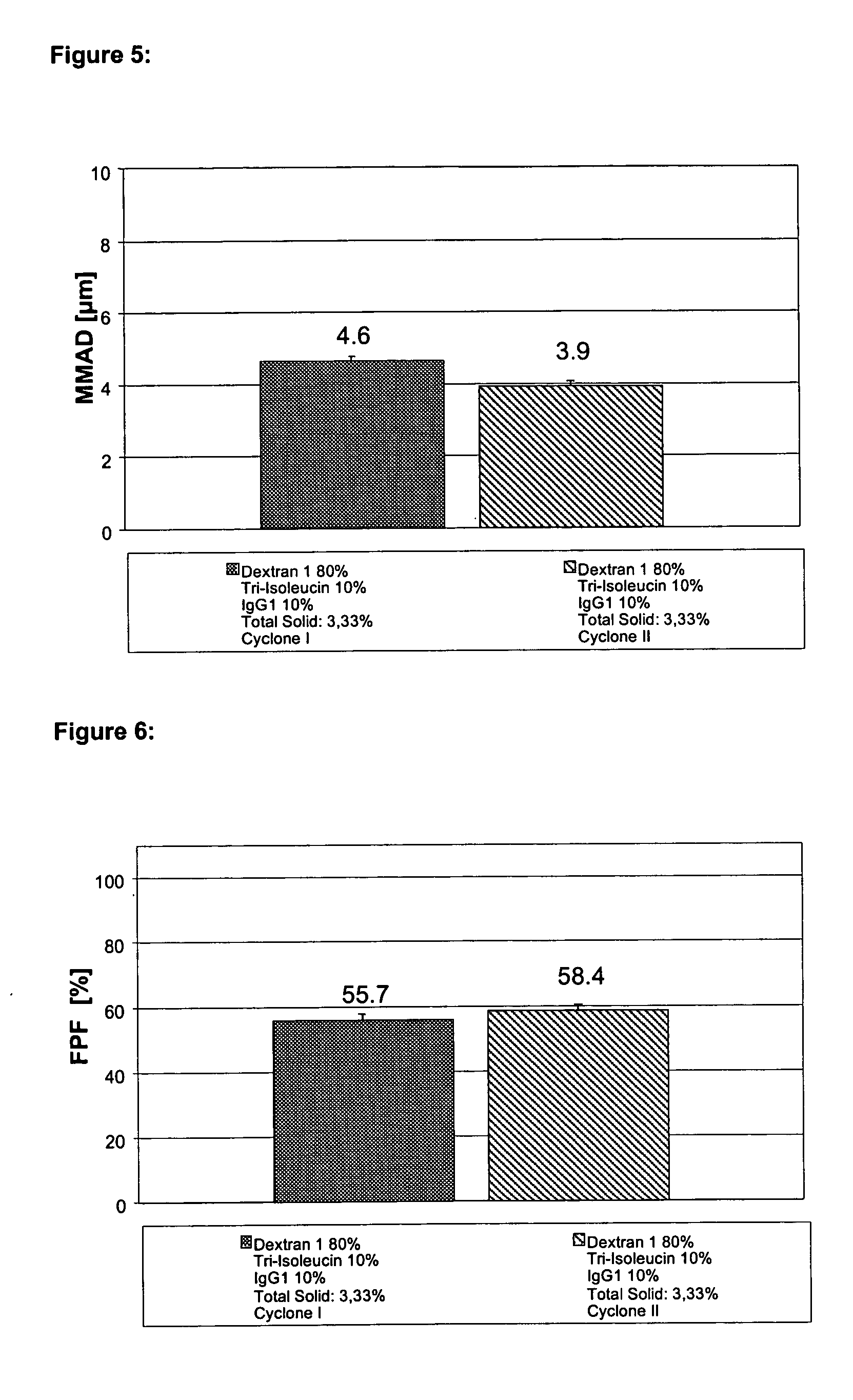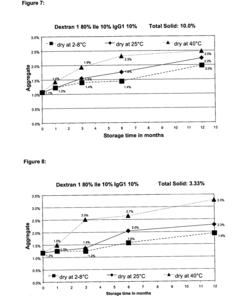How Does Spray Drying Affect Anthocyanin Stability?
SEP 25, 202510 MIN READ
Generate Your Research Report Instantly with AI Agent
Patsnap Eureka helps you evaluate technical feasibility & market potential.
Anthocyanin Stability and Spray Drying Background
Anthocyanins are water-soluble vacuolar pigments belonging to the flavonoid family, responsible for the red, purple, and blue colors in many fruits, vegetables, and flowers. These compounds have gained significant attention in the food and pharmaceutical industries due to their potential health benefits, including antioxidant, anti-inflammatory, and anti-carcinogenic properties. However, anthocyanins are highly susceptible to degradation during processing and storage, presenting a major challenge for their industrial application.
Spray drying represents one of the most widely used encapsulation techniques in the food industry, offering advantages such as operational flexibility, process continuity, and cost-effectiveness. This technology transforms liquid food products into powder form through rapid evaporation of the solvent, typically water, when atomized droplets come into contact with hot air. The process involves four main stages: atomization of the feed solution, contact between spray and drying medium, moisture evaporation, and separation of dried product.
The stability of anthocyanins during spray drying is influenced by multiple factors. Temperature is perhaps the most critical parameter, as anthocyanins undergo thermal degradation at elevated temperatures. The typical inlet temperatures used in spray drying (130-200°C) can significantly impact anthocyanin retention. However, the rapid evaporation of water during the process creates a cooling effect that may partially protect these compounds from thermal damage.
pH represents another crucial factor affecting anthocyanin stability. These compounds exhibit greater stability under acidic conditions (pH 1-3), while neutral or alkaline environments accelerate their degradation. During spray drying, local pH changes can occur as water evaporates and solutes concentrate, potentially affecting anthocyanin structure and stability.
Oxygen exposure during atomization and drying can trigger oxidative degradation of anthocyanins. The large surface area created during atomization increases contact with oxygen, promoting oxidation reactions that lead to color loss and reduced bioactivity. Additionally, the presence of light during processing can catalyze photochemical reactions that further compromise anthocyanin stability.
The historical development of spray drying technology for anthocyanin preservation dates back to the 1950s, with significant advancements occurring in the 1990s when researchers began exploring carrier materials specifically designed to protect these sensitive compounds. The evolution of this field has been marked by progressive improvements in understanding the complex degradation mechanisms and developing innovative strategies to enhance stability.
Recent technological innovations have focused on optimizing process parameters, developing novel carrier materials, and incorporating protective additives to minimize anthocyanin degradation during spray drying. These advances have enabled the production of anthocyanin-rich powders with improved stability characteristics, expanding their potential applications in functional foods, natural colorants, and nutraceutical formulations.
Spray drying represents one of the most widely used encapsulation techniques in the food industry, offering advantages such as operational flexibility, process continuity, and cost-effectiveness. This technology transforms liquid food products into powder form through rapid evaporation of the solvent, typically water, when atomized droplets come into contact with hot air. The process involves four main stages: atomization of the feed solution, contact between spray and drying medium, moisture evaporation, and separation of dried product.
The stability of anthocyanins during spray drying is influenced by multiple factors. Temperature is perhaps the most critical parameter, as anthocyanins undergo thermal degradation at elevated temperatures. The typical inlet temperatures used in spray drying (130-200°C) can significantly impact anthocyanin retention. However, the rapid evaporation of water during the process creates a cooling effect that may partially protect these compounds from thermal damage.
pH represents another crucial factor affecting anthocyanin stability. These compounds exhibit greater stability under acidic conditions (pH 1-3), while neutral or alkaline environments accelerate their degradation. During spray drying, local pH changes can occur as water evaporates and solutes concentrate, potentially affecting anthocyanin structure and stability.
Oxygen exposure during atomization and drying can trigger oxidative degradation of anthocyanins. The large surface area created during atomization increases contact with oxygen, promoting oxidation reactions that lead to color loss and reduced bioactivity. Additionally, the presence of light during processing can catalyze photochemical reactions that further compromise anthocyanin stability.
The historical development of spray drying technology for anthocyanin preservation dates back to the 1950s, with significant advancements occurring in the 1990s when researchers began exploring carrier materials specifically designed to protect these sensitive compounds. The evolution of this field has been marked by progressive improvements in understanding the complex degradation mechanisms and developing innovative strategies to enhance stability.
Recent technological innovations have focused on optimizing process parameters, developing novel carrier materials, and incorporating protective additives to minimize anthocyanin degradation during spray drying. These advances have enabled the production of anthocyanin-rich powders with improved stability characteristics, expanding their potential applications in functional foods, natural colorants, and nutraceutical formulations.
Market Analysis for Spray-Dried Anthocyanin Products
The global market for anthocyanin-based products has witnessed substantial growth in recent years, driven primarily by increasing consumer awareness regarding health benefits and the rising demand for natural food colorants. The spray-dried anthocyanin market segment specifically has emerged as a high-potential area, with an estimated market value exceeding $500 million in 2022 and projected to grow at a compound annual growth rate of 7.2% through 2028.
Food and beverage industries represent the largest application segment, accounting for approximately 68% of the total market share. Within this segment, dairy products, confectionery, bakery items, and functional beverages are the primary consumers of spray-dried anthocyanins. The pharmaceutical and nutraceutical sectors follow closely, comprising about 22% of the market, while cosmetics and personal care products make up the remaining 10%.
Regionally, North America and Europe currently dominate the market landscape, collectively holding over 60% of the global market share. This dominance can be attributed to stringent regulations against synthetic colorants and higher consumer willingness to pay premium prices for natural ingredients. However, the Asia-Pacific region is experiencing the fastest growth rate, particularly in countries like China, Japan, and South Korea, where traditional medicine practices align well with anthocyanin's health properties.
Consumer trends significantly influencing this market include the clean-label movement, growing preference for plant-based products, and increasing demand for functional foods with proven health benefits. Market research indicates that consumers are willing to pay 15-30% more for products containing natural colorants with additional health benefits compared to those with synthetic alternatives.
The competitive landscape features both established ingredient manufacturers and specialized botanical extract companies. Key market players include Chr. Hansen, Sensient Technologies, Archer Daniels Midland, and several specialized extract producers focusing exclusively on anthocyanin-rich formulations. These companies are increasingly investing in advanced spray-drying technologies to enhance anthocyanin stability and bioavailability.
Price sensitivity remains a significant market challenge, as spray-dried anthocyanins typically cost 3-5 times more than synthetic alternatives. However, technological advancements in spray-drying processes are gradually reducing production costs while simultaneously improving product quality and stability, which is expected to expand market penetration across various price-sensitive segments.
Distribution channels are evolving, with business-to-business transactions dominating the market structure. Direct sales to food manufacturers constitute approximately 75% of all transactions, while the remainder occurs through specialized ingredient distributors and brokers who serve smaller manufacturers and niche product developers.
Food and beverage industries represent the largest application segment, accounting for approximately 68% of the total market share. Within this segment, dairy products, confectionery, bakery items, and functional beverages are the primary consumers of spray-dried anthocyanins. The pharmaceutical and nutraceutical sectors follow closely, comprising about 22% of the market, while cosmetics and personal care products make up the remaining 10%.
Regionally, North America and Europe currently dominate the market landscape, collectively holding over 60% of the global market share. This dominance can be attributed to stringent regulations against synthetic colorants and higher consumer willingness to pay premium prices for natural ingredients. However, the Asia-Pacific region is experiencing the fastest growth rate, particularly in countries like China, Japan, and South Korea, where traditional medicine practices align well with anthocyanin's health properties.
Consumer trends significantly influencing this market include the clean-label movement, growing preference for plant-based products, and increasing demand for functional foods with proven health benefits. Market research indicates that consumers are willing to pay 15-30% more for products containing natural colorants with additional health benefits compared to those with synthetic alternatives.
The competitive landscape features both established ingredient manufacturers and specialized botanical extract companies. Key market players include Chr. Hansen, Sensient Technologies, Archer Daniels Midland, and several specialized extract producers focusing exclusively on anthocyanin-rich formulations. These companies are increasingly investing in advanced spray-drying technologies to enhance anthocyanin stability and bioavailability.
Price sensitivity remains a significant market challenge, as spray-dried anthocyanins typically cost 3-5 times more than synthetic alternatives. However, technological advancements in spray-drying processes are gradually reducing production costs while simultaneously improving product quality and stability, which is expected to expand market penetration across various price-sensitive segments.
Distribution channels are evolving, with business-to-business transactions dominating the market structure. Direct sales to food manufacturers constitute approximately 75% of all transactions, while the remainder occurs through specialized ingredient distributors and brokers who serve smaller manufacturers and niche product developers.
Technical Challenges in Anthocyanin Preservation
Anthocyanin preservation during spray drying presents significant technical challenges due to the inherent instability of these valuable bioactive compounds. The primary obstacle lies in the thermal sensitivity of anthocyanins, which undergo rapid degradation when exposed to the high temperatures typically employed in spray drying processes (ranging from 150°C to 220°C inlet temperatures). This thermal stress triggers structural changes in anthocyanin molecules, leading to the formation of chalcones and subsequent irreversible degradation into phenolic acids and aldehydes.
Oxidation represents another critical challenge, as anthocyanins are highly susceptible to oxidative degradation during processing. The atomization step in spray drying creates extremely fine droplets with large surface areas, maximizing exposure to oxygen and accelerating oxidative reactions. This effect is further compounded by the presence of metal ions, particularly iron and copper, which catalyze these degradation pathways.
pH stability presents a complex technical hurdle, as anthocyanins exhibit different structural forms depending on the pH environment. During spray drying, localized pH changes can occur as water evaporates and solutes concentrate, potentially shifting anthocyanins away from their stable flavylium cation form (predominant at pH 1-3) toward less stable quinoidal or chalcone structures. These pH-induced transformations significantly impact both color intensity and bioactivity.
The interaction between anthocyanins and other matrix components during drying introduces additional complications. Polyphenol oxidase enzymes, naturally present in many plant materials, can remain active during the early stages of drying, catalyzing anthocyanin degradation. Conversely, certain matrix components like polysaccharides may offer protective effects through molecular encapsulation, but optimizing these interactions remains challenging.
Water activity management during and after spray drying represents a significant technical challenge. While reducing water activity generally enhances anthocyanin stability, the rapid moisture removal during spray drying can create physical stresses on the molecular structure. Additionally, the glass transition properties of the dried powder matrix critically influence anthocyanin stability during storage, with crystallization events potentially exposing anthocyanins to degradative reactions.
Light sensitivity compounds these challenges, as spray-dried powders with high surface area may experience photodegradation during processing and storage. The technical difficulty lies in developing packaging and processing conditions that minimize light exposure while maintaining powder functionality.
Scale-up considerations introduce further complexities, as laboratory-optimized parameters often perform differently at industrial scales. Variations in residence time, temperature gradients, and atomization efficiency between pilot and production-scale equipment can significantly impact anthocyanin retention, requiring sophisticated process control strategies to maintain consistent quality.
Oxidation represents another critical challenge, as anthocyanins are highly susceptible to oxidative degradation during processing. The atomization step in spray drying creates extremely fine droplets with large surface areas, maximizing exposure to oxygen and accelerating oxidative reactions. This effect is further compounded by the presence of metal ions, particularly iron and copper, which catalyze these degradation pathways.
pH stability presents a complex technical hurdle, as anthocyanins exhibit different structural forms depending on the pH environment. During spray drying, localized pH changes can occur as water evaporates and solutes concentrate, potentially shifting anthocyanins away from their stable flavylium cation form (predominant at pH 1-3) toward less stable quinoidal or chalcone structures. These pH-induced transformations significantly impact both color intensity and bioactivity.
The interaction between anthocyanins and other matrix components during drying introduces additional complications. Polyphenol oxidase enzymes, naturally present in many plant materials, can remain active during the early stages of drying, catalyzing anthocyanin degradation. Conversely, certain matrix components like polysaccharides may offer protective effects through molecular encapsulation, but optimizing these interactions remains challenging.
Water activity management during and after spray drying represents a significant technical challenge. While reducing water activity generally enhances anthocyanin stability, the rapid moisture removal during spray drying can create physical stresses on the molecular structure. Additionally, the glass transition properties of the dried powder matrix critically influence anthocyanin stability during storage, with crystallization events potentially exposing anthocyanins to degradative reactions.
Light sensitivity compounds these challenges, as spray-dried powders with high surface area may experience photodegradation during processing and storage. The technical difficulty lies in developing packaging and processing conditions that minimize light exposure while maintaining powder functionality.
Scale-up considerations introduce further complexities, as laboratory-optimized parameters often perform differently at industrial scales. Variations in residence time, temperature gradients, and atomization efficiency between pilot and production-scale equipment can significantly impact anthocyanin retention, requiring sophisticated process control strategies to maintain consistent quality.
Current Spray Drying Methods for Anthocyanin Stabilization
01 Encapsulation techniques for anthocyanin stability
Various encapsulation methods can be used to protect anthocyanins during spray drying, enhancing their stability against degradation factors such as heat, light, and oxidation. These techniques include using wall materials like maltodextrin, gum arabic, and modified starches that form protective matrices around the anthocyanin molecules. The encapsulation process creates a physical barrier that shields the bioactive compounds from environmental stresses during processing and storage, resulting in improved stability and extended shelf life of the final product.- Encapsulation techniques for anthocyanin stability: Encapsulation methods are used to protect anthocyanins during spray drying processes, enhancing their stability against degradation factors such as heat, light, and oxidation. Various carrier materials including maltodextrin, gum arabic, and modified starches can form protective matrices around anthocyanin molecules. These encapsulation techniques significantly improve the shelf life and color retention of spray-dried anthocyanin powders while maintaining their bioactive properties.
- Process parameter optimization for anthocyanin preservation: Optimizing spray drying parameters is crucial for maintaining anthocyanin stability. Key parameters include inlet/outlet temperature control, feed concentration, atomization pressure, and flow rate. Lower drying temperatures (typically below 180°C) and shorter residence times minimize thermal degradation of anthocyanins. The addition of specific drying aids and pH adjustment of the feed solution before spray drying can further enhance anthocyanin retention and stability in the final powder.
- Antioxidant addition for enhanced anthocyanin protection: Incorporating antioxidants into spray drying formulations significantly improves anthocyanin stability. Natural antioxidants such as ascorbic acid, citric acid, and tocopherols can neutralize free radicals and prevent oxidative degradation of anthocyanins during processing and storage. These protective agents create a more favorable environment for anthocyanin molecules, reducing color loss and maintaining their functional properties in the spray-dried powder form.
- Co-crystallization and matrix engineering approaches: Co-crystallization techniques and matrix engineering approaches provide enhanced structural protection for anthocyanins during spray drying. By incorporating anthocyanins into crystalline or amorphous matrices with specific carbohydrates, proteins, or cyclodextrins, these methods create physical barriers against degradation factors. The engineered matrices can control moisture migration, reduce hygroscopicity, and provide better thermal protection during the drying process, resulting in improved anthocyanin stability and functionality.
- Post-drying treatments and storage conditions: Post-drying treatments and appropriate storage conditions are essential for maintaining long-term stability of spray-dried anthocyanins. Techniques such as vacuum packaging, nitrogen flushing, and the use of light-protective packaging materials significantly extend shelf life. Controlling storage temperature and humidity is critical, with recommended conditions being low temperature (below 25°C), low humidity, and protection from light. These measures prevent moisture absorption, oxidation, and photodegradation of anthocyanins in the dried powder form.
02 Carrier materials and additives for enhanced stability
The selection of appropriate carrier materials and additives significantly impacts anthocyanin stability during spray drying. Materials such as maltodextrin with different dextrose equivalents, cyclodextrins, and proteins can be used as carriers. Additionally, incorporating antioxidants, pH regulators, and chelating agents into the formulation before spray drying can help maintain anthocyanin integrity. These additives neutralize free radicals, create favorable pH conditions, and prevent metal-catalyzed oxidation, thereby enhancing the overall stability of anthocyanins throughout the drying process.Expand Specific Solutions03 Optimization of spray drying parameters
Careful control of spray drying process parameters is crucial for preserving anthocyanin stability. Key parameters include inlet and outlet temperatures, feed flow rate, atomization pressure, and residence time. Lower inlet temperatures (typically below 180°C) and shorter residence times minimize thermal degradation of anthocyanins. The optimization of these parameters requires balancing between efficient moisture removal and minimal heat exposure to achieve high retention rates of anthocyanins in the final powder while maintaining acceptable powder properties such as flowability and reconstitution characteristics.Expand Specific Solutions04 Pre-treatment methods for improved stability
Various pre-treatment methods applied before spray drying can significantly enhance anthocyanin stability. These include concentration techniques like ultrafiltration or reverse osmosis to reduce water content prior to drying, pH adjustment to create more stable forms of anthocyanins, and the addition of stabilizing agents. Some processes also incorporate partial dehydration steps, microencapsulation preparations, or complexation with proteins or polysaccharides before the main spray drying operation. These pre-treatments create more favorable conditions for anthocyanins to withstand the thermal stress during spray drying.Expand Specific Solutions05 Novel spray drying technologies for anthocyanin preservation
Innovative spray drying technologies have been developed specifically to enhance anthocyanin stability. These include pulsed spray drying, low-temperature spray drying assisted by dehumidified air, ultrasonic spray drying, and spray-freeze drying hybrid systems. Some approaches incorporate inert gas environments during processing to minimize oxidation, while others utilize co-current flow designs to reduce thermal exposure. These advanced technologies aim to overcome the limitations of conventional spray drying by providing gentler drying conditions that better preserve the molecular integrity and bioactivity of anthocyanins.Expand Specific Solutions
Leading Companies in Anthocyanin Processing
The spray drying market for anthocyanin stabilization is currently in a growth phase, with increasing demand driven by the food, pharmaceutical, and nutraceutical industries. The global market size for microencapsulation technologies, including spray drying for anthocyanins, is expanding at approximately 10-12% annually. Technologically, spray drying for anthocyanin preservation shows moderate maturity with ongoing innovation. Leading players include BASF Corp. and Chr. Hansen A/S, who have developed proprietary carrier systems, while academic institutions like McMaster University and China Agricultural University are advancing fundamental research. Pharmaceutical companies such as Novartis AG and Boehringer Ingelheim are exploring applications in drug delivery systems, while specialty firms like Anabio Technologies ULC focus specifically on microencapsulation technologies that enhance anthocyanin stability during processing and storage.
China Agricultural University
Technical Solution: China Agricultural University has developed an innovative spray drying approach for anthocyanin preservation that combines ionic gelation with spray drying technology. Their research team has created a two-step process where anthocyanins are first pre-encapsulated in calcium-alginate nanoparticles (100-300nm) through controlled ionic gelation, followed by spray drying with maltodextrin as a secondary carrier. This creates a "double-shell" protection system. Their process utilizes moderate inlet temperatures (130-150°C) with rapid drying kinetics to minimize thermal exposure. The university's research has demonstrated that this approach provides significant protection against pH changes, with anthocyanins retaining their characteristic color at pH ranges from 3.0 to 6.5, where conventional spray-dried anthocyanins typically degrade. Their studies have shown retention rates of 78-85% of total anthocyanin content after spray drying, with significantly improved stability during storage (less than 10% degradation after 6 months at room temperature).
Strengths: Innovative double-encapsulation approach; enhanced pH stability; good storage stability at ambient conditions. Weaknesses: More complex multi-step process; requires precise control of ionic gelation parameters; higher production costs compared to single-step methods.
BASF Corp.
Technical Solution: BASF has developed an advanced spray drying technology called "AnthoCare" specifically designed for anthocyanin stabilization in both food and pharmaceutical applications. Their approach utilizes a combination of modified cyclodextrins and specialized polymers that form molecular inclusion complexes with anthocyanin molecules prior to spray drying. This pre-complexation step shields the reactive hydroxyl groups of anthocyanins from oxidative degradation. BASF's process employs a multi-stage drying profile with carefully controlled temperature gradients (initial 120-140°C dropping to 80-90°C) that minimize thermal stress while achieving optimal moisture removal. Their technology incorporates an inert gas atmosphere (typically nitrogen) during atomization and collection phases to prevent oxidative degradation. Research conducted by BASF has demonstrated that this approach can maintain over 92% of initial anthocyanin bioactivity after spray drying, with stability extending to 24 months under proper storage conditions.
Strengths: Molecular-level protection through inclusion complexes; controlled atmosphere processing; applicable across multiple industries. Weaknesses: Higher complexity and cost compared to conventional methods; requires specialized handling of carrier materials; process optimization needed for different anthocyanin sources.
Key Research Advances in Anthocyanin Protection
Enhanced thermal stability for adenoviral vectors through spray drying
PatentWO2017035664A1
Innovation
- Development of a thermally stable adenovirus formulation through spray drying with a binary excipient matrix of dextran and mannitol, which maintains at least 40% adenovirus activity, allowing storage and transport at elevated temperatures without significant loss of function.
Powders comprising low molecular dextran and methods of producing those powders
PatentInactiveUS20050191246A1
Innovation
- Low-molecular dextran with a molecular weight between 500 and 10,000 Dalton is used as an excipient to form an amorphous matrix with a high glass transition temperature, improving the stability and flow properties of spray-dried powders, allowing for effective stabilization of biological macromolecules like proteins and peptides.
Encapsulation Materials and Carrier Selection
The selection of appropriate encapsulation materials and carriers represents a critical factor in determining anthocyanin stability during spray drying processes. Maltodextrin has emerged as one of the most widely utilized carrier materials due to its excellent film-forming properties, low viscosity at high concentrations, and good solubility. Research indicates that maltodextrins with different dextrose equivalents (DE) exhibit varying protective effects, with lower DE values (10-20) generally providing superior protection for anthocyanin compounds during thermal processing.
Gum Arabic presents another valuable carrier option, demonstrating exceptional emulsifying properties and the ability to form a protective layer around anthocyanin molecules. Studies have shown that combinations of maltodextrin and gum Arabic often yield synergistic effects, enhancing both the encapsulation efficiency and storage stability of spray-dried anthocyanin powders compared to single-carrier systems.
Modified starches, particularly those with hydrophobic modifications, have gained attention for their ability to create more effective barriers against oxygen and moisture, two primary factors in anthocyanin degradation. Octenyl succinic anhydride (OSA) modified starches have demonstrated particular promise in recent investigations, offering improved encapsulation efficiency rates of up to 95% for certain anthocyanin extracts.
Protein-based carriers, including whey protein isolate and sodium caseinate, represent an emerging class of encapsulation materials. These proteins can form complex coacervates with anthocyanins, potentially offering enhanced protection through both physical barrier effects and antioxidant properties inherent to certain protein structures. However, their application remains limited by cost considerations and potential allergenicity issues.
The carrier-to-core ratio significantly impacts anthocyanin stability, with optimal ratios typically falling between 3:1 and 10:1 depending on the specific anthocyanin source and carrier material. Higher carrier concentrations generally improve stability but may dilute the bioactive compound concentration in the final product, necessitating careful optimization for specific applications.
Recent innovations include the development of composite carrier systems incorporating cyclodextrins, which can form inclusion complexes with anthocyanin molecules, providing molecular-level protection against degradative reactions. Additionally, the incorporation of natural antioxidants such as ascorbic acid or tocopherols into carrier matrices has shown promise in enhancing anthocyanin stability during both processing and subsequent storage periods.
The physical characteristics of carriers, particularly glass transition temperature (Tg), significantly influence powder properties and stability. Carriers with higher Tg values typically produce powders with reduced stickiness and improved flowability, while simultaneously offering better protection against structural collapse and anthocyanin degradation during storage at elevated temperatures and humidity levels.
Gum Arabic presents another valuable carrier option, demonstrating exceptional emulsifying properties and the ability to form a protective layer around anthocyanin molecules. Studies have shown that combinations of maltodextrin and gum Arabic often yield synergistic effects, enhancing both the encapsulation efficiency and storage stability of spray-dried anthocyanin powders compared to single-carrier systems.
Modified starches, particularly those with hydrophobic modifications, have gained attention for their ability to create more effective barriers against oxygen and moisture, two primary factors in anthocyanin degradation. Octenyl succinic anhydride (OSA) modified starches have demonstrated particular promise in recent investigations, offering improved encapsulation efficiency rates of up to 95% for certain anthocyanin extracts.
Protein-based carriers, including whey protein isolate and sodium caseinate, represent an emerging class of encapsulation materials. These proteins can form complex coacervates with anthocyanins, potentially offering enhanced protection through both physical barrier effects and antioxidant properties inherent to certain protein structures. However, their application remains limited by cost considerations and potential allergenicity issues.
The carrier-to-core ratio significantly impacts anthocyanin stability, with optimal ratios typically falling between 3:1 and 10:1 depending on the specific anthocyanin source and carrier material. Higher carrier concentrations generally improve stability but may dilute the bioactive compound concentration in the final product, necessitating careful optimization for specific applications.
Recent innovations include the development of composite carrier systems incorporating cyclodextrins, which can form inclusion complexes with anthocyanin molecules, providing molecular-level protection against degradative reactions. Additionally, the incorporation of natural antioxidants such as ascorbic acid or tocopherols into carrier matrices has shown promise in enhancing anthocyanin stability during both processing and subsequent storage periods.
The physical characteristics of carriers, particularly glass transition temperature (Tg), significantly influence powder properties and stability. Carriers with higher Tg values typically produce powders with reduced stickiness and improved flowability, while simultaneously offering better protection against structural collapse and anthocyanin degradation during storage at elevated temperatures and humidity levels.
Regulatory Standards for Natural Colorants
The regulatory landscape for natural colorants, including anthocyanins, is complex and varies significantly across different regions and jurisdictions. In the United States, the Food and Drug Administration (FDA) regulates anthocyanins as color additives under the Federal Food, Drug, and Cosmetic Act. Specifically, anthocyanins extracted from fruits and vegetables are classified as "exempt from certification" colorants, meaning they do not require batch-by-batch testing but must comply with identity and purity specifications.
The European Food Safety Authority (EFSA) categorizes anthocyanins under E163 in the European Union's food additive classification system. The EU has established specific purity criteria and usage limitations for anthocyanins in different food categories. These regulations include specifications on heavy metal content, solvent residues, and microbiological criteria that must be met for commercial use.
When considering spray-dried anthocyanin products, regulatory compliance becomes more nuanced. The spray drying process can introduce additional components such as carrier agents (maltodextrin, gum arabic, etc.) that must also meet regulatory standards. Furthermore, any processing aids used during spray drying must be declared and comply with applicable regulations.
Japan's Ministry of Health, Labour and Welfare classifies anthocyanins as "existing food additives" and has established specific standards for their use. Similarly, China's National Food Safety Standard GB 2760 regulates anthocyanins with particular attention to extraction methods and permitted usage levels in various food categories.
Stability concerns related to spray-dried anthocyanins have prompted regulatory bodies to establish shelf-life testing protocols and storage condition requirements. These regulations often mandate stability studies under various environmental conditions to ensure color consistency throughout the product's shelf life.
Labeling requirements for products containing spray-dried anthocyanins vary by region but generally require declaration of the colorant on ingredient lists. In the EU, products must specifically list "E163" or "Anthocyanins" on labels, while US regulations require "Fruit/Vegetable Juice (for color)" or similar declarations.
Recent regulatory trends indicate increasing scrutiny of processing methods for natural colorants, with particular attention to how techniques like spray drying might affect the chemical integrity and safety profile of the final product. Some jurisdictions are beginning to require documentation of processing parameters as part of safety assessments for novel food colorant applications.
The European Food Safety Authority (EFSA) categorizes anthocyanins under E163 in the European Union's food additive classification system. The EU has established specific purity criteria and usage limitations for anthocyanins in different food categories. These regulations include specifications on heavy metal content, solvent residues, and microbiological criteria that must be met for commercial use.
When considering spray-dried anthocyanin products, regulatory compliance becomes more nuanced. The spray drying process can introduce additional components such as carrier agents (maltodextrin, gum arabic, etc.) that must also meet regulatory standards. Furthermore, any processing aids used during spray drying must be declared and comply with applicable regulations.
Japan's Ministry of Health, Labour and Welfare classifies anthocyanins as "existing food additives" and has established specific standards for their use. Similarly, China's National Food Safety Standard GB 2760 regulates anthocyanins with particular attention to extraction methods and permitted usage levels in various food categories.
Stability concerns related to spray-dried anthocyanins have prompted regulatory bodies to establish shelf-life testing protocols and storage condition requirements. These regulations often mandate stability studies under various environmental conditions to ensure color consistency throughout the product's shelf life.
Labeling requirements for products containing spray-dried anthocyanins vary by region but generally require declaration of the colorant on ingredient lists. In the EU, products must specifically list "E163" or "Anthocyanins" on labels, while US regulations require "Fruit/Vegetable Juice (for color)" or similar declarations.
Recent regulatory trends indicate increasing scrutiny of processing methods for natural colorants, with particular attention to how techniques like spray drying might affect the chemical integrity and safety profile of the final product. Some jurisdictions are beginning to require documentation of processing parameters as part of safety assessments for novel food colorant applications.
Unlock deeper insights with Patsnap Eureka Quick Research — get a full tech report to explore trends and direct your research. Try now!
Generate Your Research Report Instantly with AI Agent
Supercharge your innovation with Patsnap Eureka AI Agent Platform!
